Click the link to place an order →【 “0.32 discount” limited time】Zhang Fei’s practical electronics 2024 new super “video course”: “Abundant Harvest” hardware design, switch power supply, motor drive, microcontroller, PCB Layout all in one, 1300 lectures (currently updated more than 1000 lectures) ← click the link to place an order
How many people once hoped to be a hardware engineer? In others’ eyes, it seems that to engage in hardware design, you need to understand many things. However, after entering this profession, you gradually discover that hardware engineers are in a very difficult predicament! The reasons for this situation may be multifaceted, but one important reason is that the division of design work is becoming increasingly detailed. Each person is exposed to fewer things, but their technical depth has not deepened accordingly. In the past, hardware engineers might handle many tasks, including early-stage solution design, component selection, schematic drawing, PCB layout, debugging after the board is completed, and writing driver programs. Sometimes they would also write some upper-level testing programs. If the board contained logic devices, they could also write logic. However, with the intensification of specialization, the solutions are now handled by system design engineers, and even component selection is not something they have to manage themselves. After someone else selects the components, they only need to carefully follow the datasheet for design. More often than not, chip suppliers provide reference designs, and you just need to follow them. The schematic design is not entirely your responsibility; power supply design is handled by dedicated power engineers, and some specific technologies are also managed by specialized engineers. In the end, you realize that you are just a wire engineer who connects lines on the schematic! After finishing the schematic, you do not even draw the board yourself; instead, you have dedicated EDA design engineers to help you draw. You only need to tell them what to pay attention to, but often there are communication difficulties. You may not know how to operate PCB design software or may not be proficient in it, while others do not understand your design rules. In the end, you find that the designed PCB always has defects.
Regardless, the board is finally processed and you find components to send out for soldering. Originally, you might have started soldering yourself, but now there are dedicated soldering workers to help you. After the single board is soldered, it is time for debugging, which might be the most hands-on phase for you. However, because many people participated in the design and review during the earlier design stages, most of the time you only discover some careless mistakes. More profound errors are not so easy to identify, as many components are not designed by you. After the debugging of the single board is completed, testing begins, which is something many hardware engineers dislike because this testing phase is quite tedious. Although it is very important, it consumes not only energy but many other resources.
After the entire single board debugging is completed, various reliability tests begin. At this point, the hardware engineer only needs to set up the environment, and then EMC engineers, thermal design engineers, etc., come to conduct tests, gather data, and analyze it. If there are problems, the hardware engineer needs to correct them, and then the above process is repeated.
The biggest workload for hardware engineers in the entire design process is in documentation writing and process communication. The other main areas reflecting workload are schematic drawing and debugging, but these two phases do not demonstrate much technical content. Hardware engineers often lament that they understand less and less, or that they have transformed into wire engineers!
So, hardware engineers, have you really turned into wire engineers? Where is your future?!
1. What is hardware?
In other words, hardware is physical, at least something you can see and touch. It is a material carrier, a material basis. Broadly speaking, all humans live on a material basis. You can refer to everything you can see as hardware. Of course, in a narrow sense, software and hardware generally refer to the electronic field.
Software code is also written by people. Familiar languages like C, C++, etc., are translated into assembly language by a compiler, and then assembly language is translated into binary machine language by an assembler. Machine language controls gate circuits to complete corresponding actions. I personally believe that without hardware, software has no meaning of existence; hardware is the foundation of everything, which shows how important hardware design is.
However, software and hardware have obvious distinctions, at least their work contents differ significantly. According to industry descriptions, hardware belongs to the lower level (commonly referred to as low-level hardware), while software is considered upper level (software is further divided into: low-level drivers, upper-level business, and application layers, etc.). If we must give an example to illustrate software and hardware, the best example is a person: hardware refers to the body, while software refers to thinking.
In fact, for people outside the electronic field, it is difficult to understand how computers work, how hardware works, and how software works. Even if you know everything is 0 and 1, if you have not done related work, you cannot discover the wonders within. Actually, you just need to know that software drives hardware to work. What drives it? It’s electric signals! The electrical signals received by hardware are divided into 0 and 1. The response speed of hardware is very fast. How fast? For example, the commonly used serial port baud rate in hardware is 115200 bits per second, which means 115200 0s or 1s in one second. An English letter is 8 bits (as seen in the ASCII table, which is learned in college), meaning that 14400 letters can be printed in one second. You can blink, and over ten thousand letters come out. Of course, in reality, it doesn’t work like that; this is just a figurative example.
However, in circuit design, 100kHz is considered a relatively slow rate. For example, the refresh frequency of a display is more than 24 frames per second, which our eyes cannot perceive. The data for 24 frames is enormous; for example, 1080p30 format output has a total data volume of one second: 1920*1080*12*30 = 746496000 0s or 1s, which is 700 million 0s or 1s.
2. What is hardware design?
Generally speaking, hardware design refers to circuit design. This statement is not wrong because all your work revolves around circuit design, and the ultimate goal is to produce an excellent circuit that meets various requirements and undergoes various tests. However, in reality, we require a product, not just a single board.
There is an article online that describes well: “Hardware design is based on the product manager’s requirements PRS (Product Requirement Specification), under the constraints of COGS (Cost of Goods Sale), using currently mature chip solutions or technologies to complete the requirements of:
-
PRS function (Function)
-
Performance (performance)
-
Power supply design (power Supply)
-
Power consumption (power Consumption)
-
Thermal (Thermal/Cooling)
-
Noise (Noise)
-
Signal integrity (Signal Integrity),
-
Electromagnetic radiation (EMC/EMI)
-
Safety regulations (Safety)
-
Component sourcing (Component Sourcing)
-
Reliability (Reliability)
-
Testability (DFT: design for test)
-
Manufacturability (DFM: design for manufacture)
And other hardware products that meet the above requirements (Note: it is a product, not a development board). It can be seen that the implementation of a successful hardware design’s main function is only a small part of all processes. When starting work, one might think that completing the circuit design means 50% of the job is done, while PCB return means 80% of the job is done. In reality, that’s not the case; the PCB return primarily achieving its main functionality means less than 30% of the work is done. Therefore, whether in terms of time or stages, product hardware design is a long process.
Moreover, when you work on product hardware design in a company, you generally refer to mature solutions. The main functions of the core chip CPU are ultimately based on the chip manufacturer’s provided chip solution. Generally, to reduce risk, you mainly refer to the reference design provided by the chip manufacturer, which includes device packaging, reference design, simulation models, PCB references, etc. In today’s world, where chip functions are increasingly complex, a chip can have hundreds or thousands of pins. For a new project, there is no time to thoroughly understand each pin and its specific functions and electrical parameters, especially for high-speed designs like DDR3 interfaces, XAUI interfaces, etc. Generally, the reference design provided by chip manufacturers is their best solution after development, verification, and testing. Many times, you must follow the reference design; otherwise, the hardware may have problems, typically signal integrity or EMC issues.
Some people say that hardware circuit design cannot be considered design, as it is all about copying mature circuits. Chip manufacturers provide increasingly comprehensive services, and combined with the technical accumulation of the company, hardware design engineers can design circuits without thinking. It seems that the value of hardware engineers (HWE) is decreasing, as the core functions or technologies of a product generally reside in ICs or FPGAs, and HWE generally lacks the capability to conduct core logic design IC design. If we follow this logic, software design cannot be considered design either, as it is also about copying mature codes. How many software developers do not port others’ codes? To go deeper, how many software engineers can freely modify uboot, kernel, without searching for C language syntax, without porting business programs, or without asking for technical support from chip manufacturers?
Even if they are all mature products, I have not found any project that is completed quickly. The same set of circuits and codes, mature products have no issues, but why do new products have problems?? In the end, it is still the hardware design that resolves the issues.
Regarding the above issues, I have also been confused. I always felt that hardware design was no longer interesting, as it was merely copying reference designs, akin to assembling a computer or a single board. However, with increasing project experience, especially from my current role in hardware system-level design, I feel that my previous perspective was limited, viewing issues solely from the standpoint of a schematic design engineer. As mentioned earlier, a successful hardware design’s function is only a small part. The more factors and capabilities a HWE can consider, the deeper they delve, the more excellent a HWE engineer they become.
So, HWE relies on experience. For companies, training an HWE is costly. Hardware does not allow for quick fixes like software; if a hardware design has errors, it may require starting over, delaying the entire project cycle by three weeks or even more than a month. For example, recently encountered issues with a SENSOR displaying poor image quality and numerous bright spots, but hardware circuits cannot be bypassed, which relates to layout and wiring, necessitating board modifications.
It is important to clarify that anyone can accomplish tasks without understanding anything, but for individuals, there will be a development ceiling. In terms of hardware, you can use reference circuits without knowing how they work; in software, you can use uboot and kernel without understanding them. However, once you comprehend, it makes a significant difference. When it comes to hardware design, many believe it is simple circuit design, with no difficulty, but in reality, the lower you go, the more challenging it becomes, and the greater the responsibility, along with more inter-departmental communication. The more you understand, the easier it is to learn, and the further you can go.
3. What is hardware circuit design?
As the name suggests, hardware circuit design is about designing circuits. You should be proficient in using Cadence to draw circuits and view PCBs. In hardware design, circuit design is the most important responsibility of HWE. Circuit design tests the basic skills of HWE, including understanding and flexibly applying various hardware components, such as:
-
CPU
-
Resistors, capacitors, inductors,
-
Diodes, transistors,
-
Protection devices, interface devices,
-
Logic chips, logic functions,
-
Small chips
-
Power supply
As I am a graduate in EMC, I have deep feelings about the considerations during design. The 13 aspects of hardware design we discussed should be considered during design. The various processes in large companies ensure good inter-departmental collaboration during the design phase.
Every company will have its own hardware circuit design specifications, which you need to review and apply in practice. Hardware circuit design mainly focuses on circuit design, which involves many aspects. There will be a separate chapter discussing the design of circuit modules. Hardware circuit design requires sufficient experience and theoretical knowledge.
4. Hardware design development process
After the hardware department development process is designated, personnel in the hardware department must strictly follow the development process to complete their work. The hardware development process is primarily divided into the following steps:
1) Market research
For upcoming projects, market research needs to be conducted.
2) Project initiation
After completing market research, the first step is to initiate the project.
3) Overall hardware design
Once the project is initiated, overall hardware design needs to be conducted.
4) Experimentation of core components and detailed design of sub-modules
After completing the overall design, experiments on core components need to be conducted, and design schemes for sub-modules should begin.
5) Circuit, program, and enclosure design
Once the experiments and detailed designs of core components are completed, circuit, program, and enclosure design should be carried out. The circuit, program, and enclosure design should follow project specifications.
6) System integration testing
Once each sub-block is debugged, system integration testing can be conducted.
7) Internal review and project acceptance
Once system integration testing is complete, the project can undergo internal review and acceptance.
5. What is a hardware engineer?
A hardware engineer is responsible for the overall hardware design of a product.
5.1. Responsibilities of a hardware engineer
First, let’s look at the R&D division of a large company, as shown in the diagram, to see your department and position.
The R&D process for a hardware product is illustrated in the diagram below:
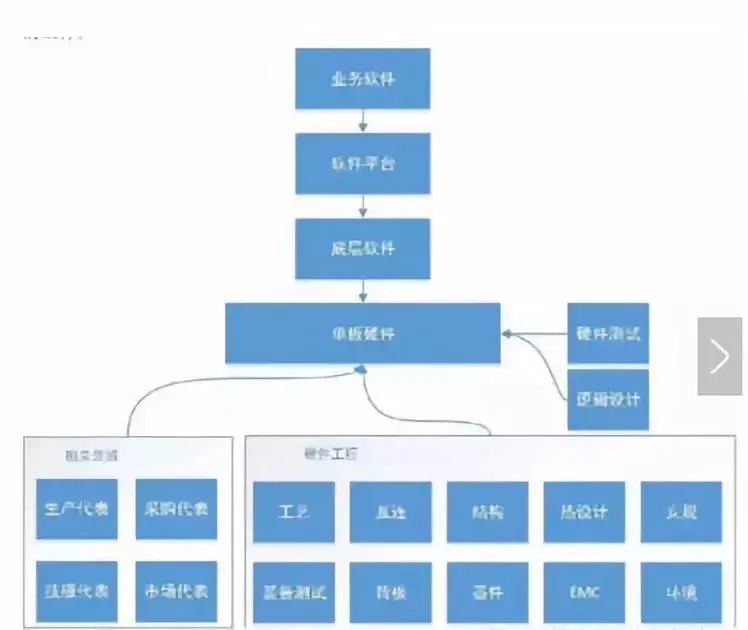
All positions within the company are equally important.
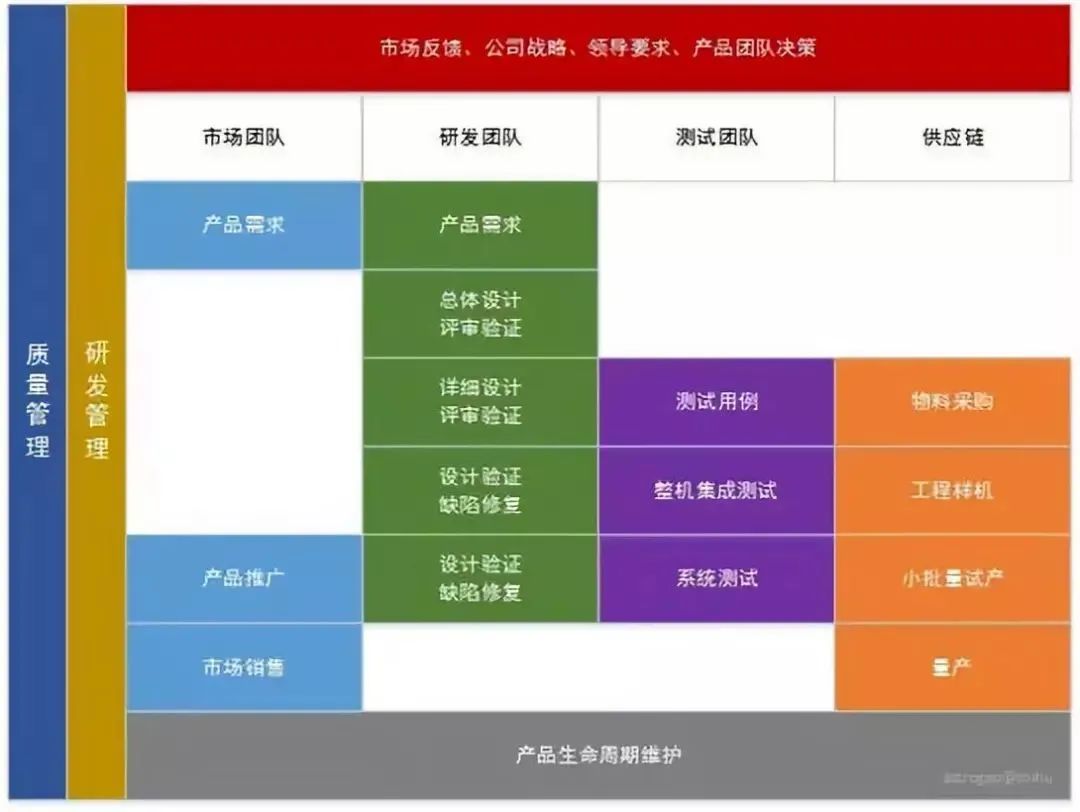
Although the importance of each team is equal, the R&D team should play a more core role in product development. R&D personnel can switch to roles in marketing, testing, supply chain, or quality management, but it is challenging for personnel in marketing and other positions to transition to R&D. Firstly, R&D has a high threshold, and secondly, R&D work encompasses a broad range. Within the entire R&D team, hardware engineers play a leading role.
Generally, when we talk about R&D, it is not limited to software and hardware, but encompasses the entire project team, including product leaders from almost all departments.
Hardware engineers are an important part of the R&D team, and the R&D team for hardware products can be illustrated as follows:

Of course, the diagram does not fully represent this, as thermal design is also a very important member. However, it should be noted that within the entire project R&D team, two individuals interact with everyone: one is the project manager, and the other is the hardware engineer. Hardware engineers need to communicate and coordinate with various R&D personnel, which requires them to have a broad knowledge base and strong coordination abilities.
The primary duties of a hardware engineer are illustrated in the diagram below:
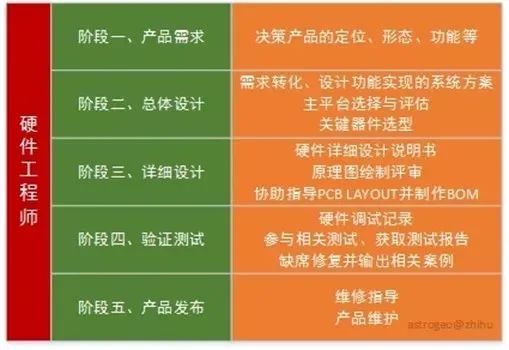
Hardware engineers can generally be divided into the following four stages:
Junior hardware engineer
Completes parts of stages three and four under the guidance of others. This is achievable for fresh graduates within three months.
Ordinary hardware engineer
Independently completes work in stages three and four, typically achievable after 1 to 2 years of work.
Senior hardware engineer
Leads the completion of stages three and four, participates in the overall design work of stage two.
Expert hardware engineer
Leads the completion of stages one and two.
5.2. Timing control
As a hardware engineer, you are responsible for the entire product development process. Therefore, you must accurately control each time period. Projects will have project cycles, and although project managers oversee timing, it is the hardware engineers who handle the specific operations. Personally, I am currently in stage three and have no clear time concept for stages two and one. For projects progressing normally:
Schematic and detailed design plan: 5 weeks, including reference design and schematic review.
PCB layout and wiring: 4 weeks, including collaboration with structures, circuit adjustments, or component re-selection.
Board submission and waiting for board return: 2 weeks. These two weeks are the most relaxed; while submitting the board, BOM upload must also be completed, which cannot be forgotten. Review your drawings!
Board return inspection: 1 week. Run your board, ensure uboot can be burned, and check if the network can ping. Inspect for any soldering issues. Contact the structural team for machine assembly and check for structural problems.
Driver debugging: 5 weeks, collaborating to complete all low-level function debugging.
Media version: 2 weeks, which is the first complete machine version after driver debugging, prepared for testing.
Signal testing: 3 weeks, cooperating with signal testing personnel to complete signal testing. At the same time, prepare boards for business R&D personnel.
Function testing: 2 weeks, collaborating with function testing personnel to complete environmental testing, protection against static surge testing, and other functional tests, including EMC testing.
Bug resolution waiting: 2 weeks, to resolve all bugs that arise!
Board modification and submission: 2 weeks.
……
The specific timing will vary with the complexity of the product; the above is just my general understanding and cannot be generalized.
5.3. Essential work of a hardware engineer
Goal: Zero defects in the product
Process: Design circuits, resolve bugs, and communicate across departments.
Ability: Primarily focused on bug resolution capabilities.
Result: One word—busy!!!!
5.4. Basic qualities and skills of hardware engineers
Here is a positioning from Huawei’s hardware engineer manual, which looks quite good.
6. What personality traits should a hardware engineer possess?
Communication skills must be logical, and ideas should be comprehensive to communicate well with personnel from other departments; failing to articulate can lead to arguments!
Gentle personality is important because you will be communicating with all departments. Do not have a serious face or be commanding; an extreme personality can lead to arguments!
Humble and cautious—listen to others’ opinions even if not adopted, then express your insights and reasons. Being obstinate can lead to arguments!
Serious and meticulous—circuit design requires seriousness and meticulousness; resolving bugs also requires careful attention because if problems arise, the sole responsibility falls on you!
Patience is essential, whether in communication, bug resolution, or circuit inspection!
Ask when unsure—if you do not understand something, ask, as product development time is short, and you cannot afford to spend a lot of time researching!
Responsibility—be responsible for the circuit, the product, and the bugs!
Prioritize—when problems arise, think first about how to resolve the issue, rather than immediately assigning blame!
Eager to learn—be willing to help others and learn, and must have solid practical experience and theoretical knowledge!!!
In summary, the above are essential personality traits for a hardware engineer, and none can be overlooked. People with extreme personalities are unsuitable for hardware R&D and, in fact, for all R&D. Therefore, generally speaking, many hardware engineers transition to product managers because this position itself has high requirements, and good character along with experience and theoretical knowledge will lead to continuous improvement.
7. Confusions faced by hardware engineers
When I first started, I was working with microcontrollers and was very interested in holistic design. Therefore, in most projects, software, hardware, and even structures were all handled by me.
In reality, the core is not the actual details; you can find various specialized professionals to handle the details of hardware circuit boards. What you should focus on is the overall design.
Initially, you may struggle with issues like level matching and signal frequency. However, after completing five or ten projects, as long as you are good at summarizing, you will realize that the most important aspect is the overall design.
Hardware needs to be continuously enriched; continuous learning and improvement are necessary because the field of hardware engineering is complex.
8. Example explanation
1. Technical learning
Taking Bluetooth as an example: you need to know antenna design, feed line design, and finally impedance matching, as well as the use of vector analyzers. Each branch, antenna design, RF electronic circuits, and instrument usage is a field you could study for a long time, perhaps even a lifetime.
Bluetooth is divided into hardware and software parts. The software part is further divided into protocol stacks, OS parts, drivers, etc. All of these are areas we need to continuously expand and enrich. As a hardware engineer, you need to constantly broaden your horizons, understand the entire system, and communicate with engineers from various fields to gain a clearer understanding of the product as a whole.
2. Market understanding
Cost reduction is always what companies aspire to! We need to lower costs, and we need to be familiar with the selection, types, costs, cycles, and channels of each component. Understanding market dynamics, such as what others use and why, how to break through our products, and improve cost performance, is essential, even to stand out like Apple did.
3. Project management and quality management
Hardware engineers always face issues: production line problems come to you, material supply issues come to you, product returns come to you, and on-site maintenance comes to you. These are all opportunities for improvement. So the question arises: use scientific methods to get things done and learn more about quality management and reliability design knowledge.
During production, many soldering issues must be considered, such as false soldering caused by furnace temperature, and how to check BGA soldering conditions with X-ray; these are all things we need to know.
4. Knowledge accumulation
Technical aspects are also divided by industry, such as video and audio coding, transmission formats (bt1120 h323), etc.
Additionally, pure knowledge accumulation includes signal integrity, power integrity, PCB design, assembly production installation experience, and AC DC power design, etc.
9. Overall analysis
When designing a product, the first step is to consider it from a market perspective: target audience, solving pain points, advertising methods, and ensuring material stability. We must focus on logic and structural materials for our products. In advertising, we will consider highlighting the outstanding features of the product, which leads us to a basic understanding of the product’s fundamental thinking.
1. Planning design, product functionality, and refining details
We need to continuously communicate based on the product manager’s ideas to generate new innovative ideas that enhance the product’s functionality and detail, thus providing a foundational understanding of the product’s larger framework.
2. Function realization
At this point, we need to find the original factory and suppliers to understand the chips and select suitable ones.
Chip parameters: power consumption, power quality (current ripple, surge current protection, timing, etc.)
Chip procurement: lead time, tiered pricing, contracts, NDAs, service quality.
Once we have a basic idea, we can create an overall block diagram.
Lastly, a crucial point is to illustrate the thought process in a block diagram for review.
3. Schematic
This phase requires the most time. If it is a new product, most of the time will be spent reading documents and familiarizing yourself with the chips.
Common issues encountered during schematic design include: Input Capacitance pull-up, pull-down functions, compatibility, power consumption, power supply, impedance matching, jitter, rise time, IO levels, heat dissipation, control logic unified chips, debugging ports, extensibility of functions, and various clock signals (focus on main clock and bit clock) maximum and minimum levels, etc.
4. PCB design
This is a task that relies heavily on experience. Under the guidance of an experienced engineer, you will quickly learn many PCB drawing techniques. However, if you want to understand why, you need to ensure your theoretical knowledge is solid; the more solid your theory, the better your ability to apply it broadly.
Common issues in PCB design include: line width, ground plane, copper thickness, package issues, assembly failures, distance from board edges, impedance control, differential pairs, etc.
5. Drivers
This first requires an understanding of the Linux framework or related OS like uCos or FreeRTOS. Even bare-metal understanding of the microcontroller’s bus architecture is essential to write the corresponding framework (to be supplemented).
Register configuration tests your industry-specific skills. For example, in audio, you need to know what AAC, SBC, LDAC encoding is, encoding and decoding speeds, PGA, gain control, echo cancellation, and feedback suppression, etc. This area involves a lot of related knowledge and is one of the most important areas of industry accumulation.
6. Application layer and business logic
This area is relatively simple for me, but it often leads to issues with variable types, overflow, logic if-else redundancy, etc., to accommodate different hardware performance improvements.
7. Testing
This part involves using instruments and includes certifications, drop tests, surge tests, static electricity, and interference from the power frequency, etc.
10. Current status of hardware engineers?
1. Perhaps we should examine ourselves
Recently, several engineers in the Shui Mu community expressed their views on the “technical status of hardware engineers”.
@feiy: “Many hardware engineers do not know what ‘power integrity’ is.”

Envy the high salaries in the internet sector, but ask yourself, are you a qualified hardware engineer?
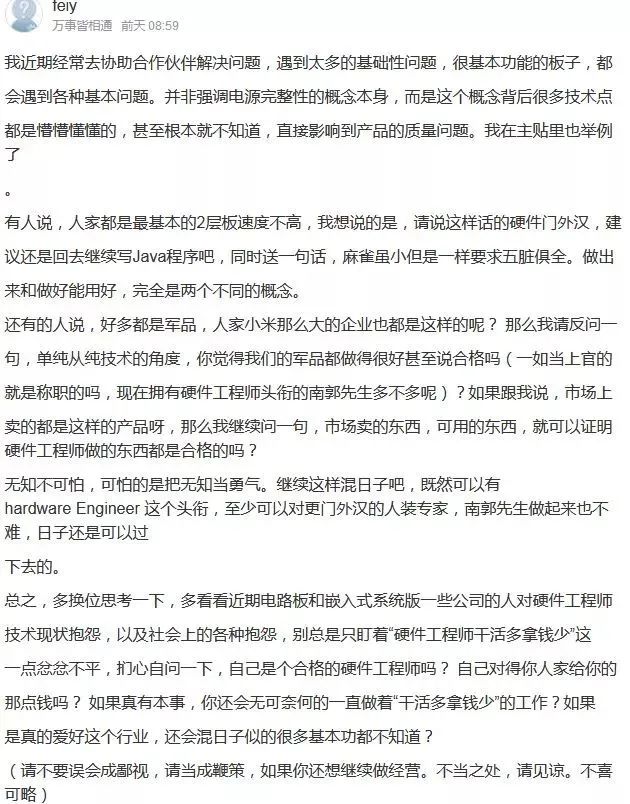
@dormouseBHU: “211 electronic engineering master’s degree, does not know transmission line equations, yet wants to discuss impedance matching issues with me.”

“Many hardware engineers are in this situation, and they cannot conduct in-depth research.”
Is hardware really that difficult?
@commandosren: “Because many products do not have high rates, the requirements for strict SI PI are not necessary, especially for small appliances and smart hardware control boards, where basic connectivity suffices, and there is no need for any specific rules. People who make these boards may have been in the industry for ten years but remain at that level, yet their products are fine. It is said that software has a low threshold, but hardware does not either.”
A heart-wrenching comment from a friend: “Even if you are proficient in power integrity, how much higher can your salary be than others?”
2. Is the trend just an excuse for the ‘uselessness of technology’?
Viewpoint 1: Hardware engineers should look at trends; “working hard and drilling deep” may not always be suitable.
What future does a purely hardware engineer have?
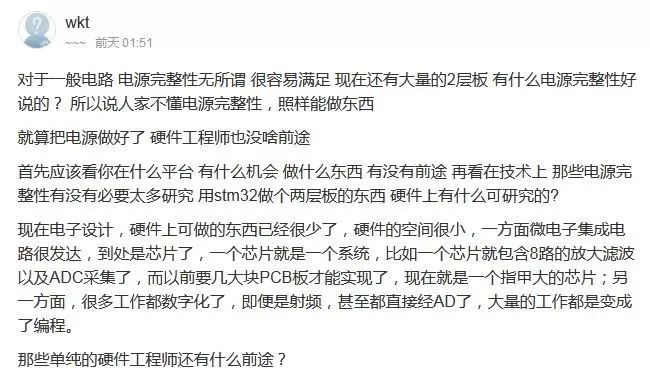
Without opportunities and platforms, even the most skilled may only do outsourcing.

However,
Viewpoint 2: “Without solid skills, even if opportunities come your way, you cannot seize them; even with platforms, you remain just a screw.”
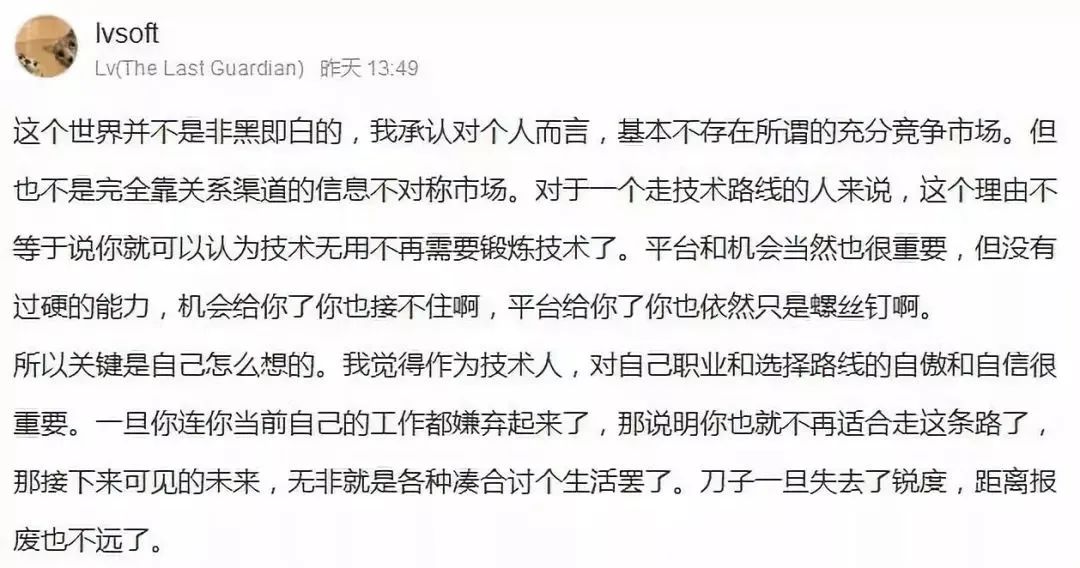
Independent hardware engineers are not cheap.
After seeing a post about an AI fresh graduate with an annual salary of 800,000, are you feeling the urge to “retrain” or “change majors”? You are not alone.
However, hardware engineers with mediocre capabilities, are you sure you can become the “AI PhD” that BATs are fighting for?
11. About ‘Youth Jobs’ and ‘Getting Better with Age’
In the past, at a research institute, some senior engineers were frequently rehired to solve difficult issues on-site, while young engineers were often at a loss. When the old professors stepped in, the problems were quickly resolved.
Years ago, people would say: “Programmers are youth jobs, while hardware is good; hardware gets better with age.”
Now, fewer people say this; why is that?
Have hardware engineers ceased to be valued with age? Are they becoming youth jobs?
“Why is there a perception that older engineers are more valuable?” The advantage of older engineers lies in their accumulated experience, but their energy and physical strength may not surpass that of younger engineers. The work of hardware engineers requires considerable time for accumulation and understanding, with a certain technical threshold.
“Why is there a perception that youth jobs exist?” The advantage of younger engineers often lies in their willingness to embrace new things, fast learning speeds, and relatively lighter family burdens.
Ultimately, every profession requires accumulation and experience; therefore, programmers cannot be seen as purely youth jobs, as becoming an excellent software engineer also requires extensive coding accumulation and experience.
Author Malcolm Gladwell in his book “Outliers” points out: “The reason people see geniuses as extraordinary is not that they are born with superior talent, but because they put in continuous effort. 10,000 hours of practice is the necessary condition for anyone to transform from ordinary to extraordinary.” He calls this the “10,000-Hour Rule.” To become an expert in a field, it takes 10,000 hours; calculated proportionally, if you work eight hours a day, five days a week, it takes at least five years to become an expert in a field. This is the 10,000-Hour Rule.
So why do people feel that hardware engineers are also becoming youth jobs?
【The entry threshold for hardware technology has indeed lowered】
Firstly, due to the advancement of tools, chip improvements, especially the development of digital circuits, and the increasing capabilities of software, the gradual realization of cloud architecture—indeed, the entry threshold for hardware technology has lowered.
Advancement of tools: Tools like Saber, ADS, Multisim, Cadence, etc., are becoming increasingly powerful. Many experiences that previously required production to observe data, waveforms, and circuit characteristics can now be analyzed and optimized through simulation tools before circuit production. The improvements in embedded software tools also lower the entry threshold for embedded software development.
Advancements in chips: The high integration of chips significantly reduces the complexity of PCB design. For example, in switch power supply design, chips with integrated MOSFETs can handle increasingly high power loads, simplifying the design complexity for hardware engineers regarding schematics and PCB layout. The development of SoCs, where MCUs and CPUs have stronger functionalities, and increasingly more integrated peripherals like storage, ADCs, and DACs, further enhances parameters. Even some RF functional components have seen increased integration; domestically, single-chip equalizers can achieve dimensions of 1mm*0.7mm. Zynq integrates FPGA and ARM, while Intel’s acquisition of Altera plans to launch X86 integrated FPGA chips, reducing the interconnection demands of high-speed buses. In earlier years, some algorithm implementations were limited by the ADC rates and DSP processing capabilities, and were often realized through analog circuits, but now these situations are hardly seen.
As chips develop, will there come a day when chip connections are simply made to interfaces to complete designs? It’s uncertain.
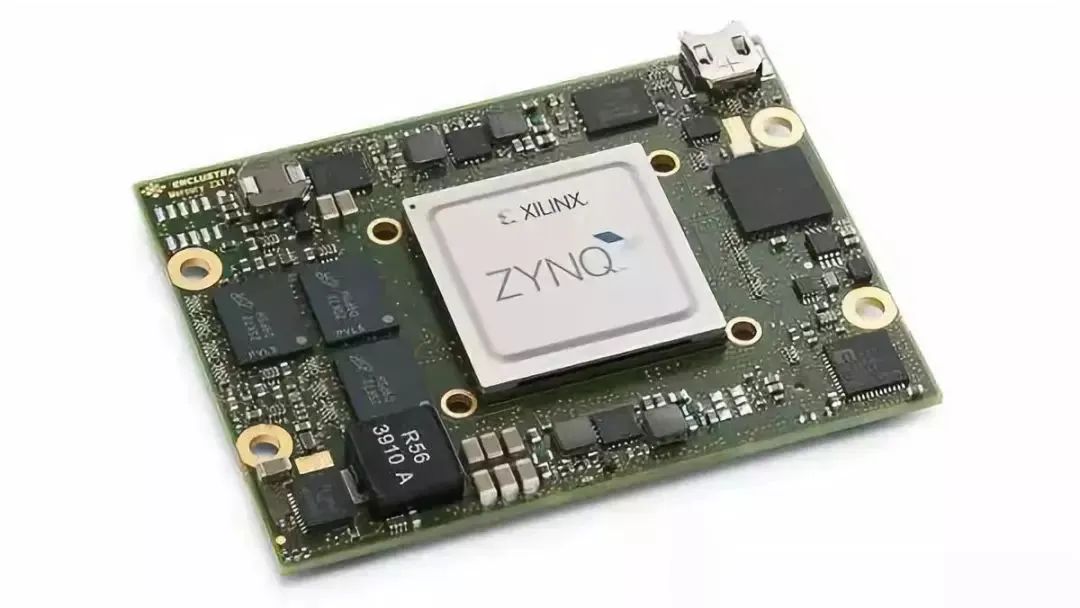
Realization of cloud architecture: In the development of smart hardware, the most significant issue is connecting products to the cloud and achieving perfect compatibility between software and hardware. Cloud computing is the core technology for realizing the Internet of Things, and as an essential tool in the development of smart hardware, the cloud can ensure reliable transmission, storage, and backup, guaranteeing manageable and controllable backend processes.
A well-functioning cloud can lower the operational costs of the entire product, provide an entry point for user interactions, and increase opportunities for understanding user needs, thereby continuously improving products. In a sense, only devices that include cloud access are truly excellent products suitable for current market development.
By placing computing and storage in the cloud, and normalizing server operations, the requirements for hardware design in the cloud are effectively lowered. Simultaneously, the realization of full IP in communication fields significantly raises the normalization of terminals, reducing the types and numbers of interfaces; the terminal mainly focuses on sensor data collection and interface presentation, and with the development of MEMS, the workload for developing analog circuits for sensors is decreasing.
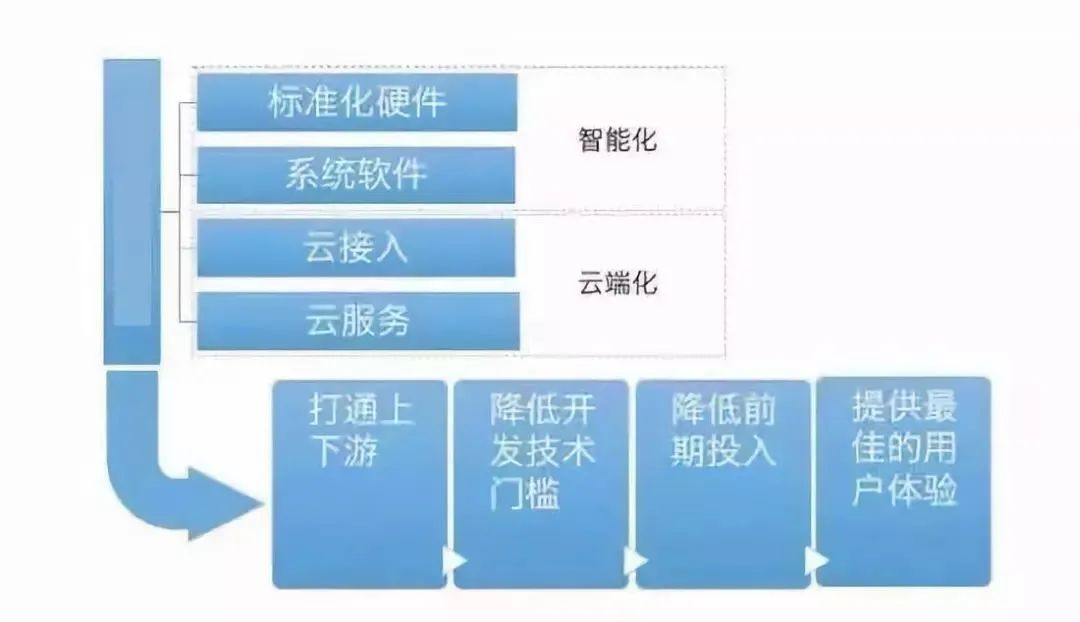
12. Where is the road ahead?
If “hardware is merely connecting wires,” then does it not mean that anyone can create hardware products without experience and accumulation?
Simple hardware versus complex hardware: I have always believed that hardware design should distinguish between “simple hardware” and “complex hardware.” Some simple hardware, such as MP3 players, electronic greeting cards, and Bluetooth headsets, have relatively simple circuit structures, low development thresholds, and do not require engineers with extensive experience to develop; the issues are generally manageable. Even if problems arise, the cost of checking and fixing them is not particularly high, so the requirements for engineers are not very stringent. However, when the circuit power exceeds 20W and the pin count exceeds 10k, managing the design and debugging of the circuit becomes complex, and once issues arise, they are often not easy to analyze and address. Therefore, when your product involves complex hardware design, it is still advisable to seek out professionals or experienced engineers who can at least provide problem-solving insights.
Simple hardware is more suitable for enterprises and individuals with advantages in supply chains to develop and innovate.
Moving into RF: Given that ADC rates are limited, not all systems can be made into software-defined radios, so RF circuits still require experience and hardware design. However, due to the power of simulation tools, the proficiency of RF engineers in using software becomes more critical, rather than relying solely on extensive experience as in the past, which required a deep understanding of theoretical knowledge. RF still requires a certain barrier due to the need for profound electromagnetic theory knowledge. If you work in RF-related fields, congratulations, your stronghold has not yet been breached. However, as trends develop, RF work will also become simpler.
Entering chips: During my time at Huawei, some senior engineers with a hardware background and a solid theoretical foundation in network protocols, product application experience, and deep understanding of processors, transitioned to “HiSilicon” to plan or design chips and have done well. Due to hardware personnel’s extensive accumulation of chip application knowledge, they can easily think from the perspective of chip design, making it a worthwhile choice to enter chip development.
In the future, as China’s demographic dividend diminishes and labor cost advantages disappear, SMT and PCB processing may disappear from China, similar to the situation in Europe and the United States, where low-value-added product manufacturing is no longer viable. Instead, production may shift to regions like India and Vietnam that still possess labor cost advantages.
13. Combining software and hardware to become a versatile talent
The efficiency of a multi-knowledge structure exceeds that of single knowledge operation efficiency. The structure of a person’s knowledge system is similar to that of a company; efficiency exceeds operational efficiency.
Knowledge is similar; when we only consider software aspects, we may overlook hardware costs, and vice versa. Combining software and hardware can help find the lowest overall cost point from a technical perspective. In projects, software can simulate interfaces using IO ports, such as SPI master, I2C master, I2C slave, UART slave, and UART master. Sometimes, when a microcontroller lacks these interfaces and you cannot change the design in time, software can reduce hardware development costs. For filtering some analog signals, after ADC conversion to digital signals, both analog filters and digital filters can be used. The two can be combined, requiring fewer hardware components and less computational load on the software. Otherwise, the significant changes brought by higher-capacity chips are not trivial. Both software and hardware engineers face challenges.
In the embedded field, becoming a software-hardware integrated engineer, even including structural design, ID design, website design, RF, and becoming a comprehensive talent, increases the likelihood of becoming a geek. You only need one idea to take action and change the world. At the same time, full-stack engineers can venture into engineering and system integration.
Elevating to system designer: In Huawei’s technical development path, a hardware engineer has three paths to choose from: 1. Manager; 2. Hardware expert; 3. System engineer. Observing the development paths of engineers across Huawei’s product lines, hardware engineers find it easier to become system engineers, while software engineers more easily transition to project managers.
This is due to the more comprehensive knowledge system of hardware engineers, making it easier for them to understand the work in other fields.
The Huawei hardware engineer qualification comparison table (table sourced from “Baidu Wenku”)
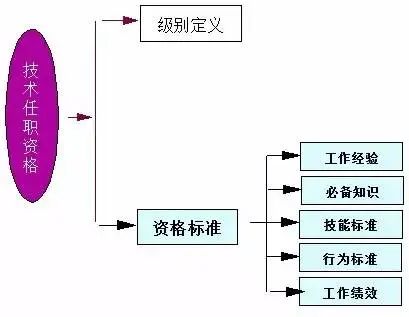
|
Qualification Level |
Work Experience |
|
Level 1 |
1+ years of hardware work experience; familiar with basic hardware knowledge, capable of independently handling general hardware technical issues. Experience in independently completing detailed design and schematic design of single boards, or basic online equipment maintenance experience. |
|
Level 2 |
After obtaining hardware or related technical qualifications, continue to engage in hardware work for 1+ years. Capable of independently conducting hardware development, completing overall design to unit testing of single boards, and possessing basic knowledge in product engineering. Alternatively, possess over 3 months of online equipment maintenance experience and the ability to independently resolve general online issues. |
|
Level 3 |
After obtaining Level 2 hardware or related technical qualifications, continue to engage in hardware work for 2+ years. Experience analyzing single board requirements and completing the entire development process, possessing comprehensive knowledge in product engineering, experience in developing complex single boards or simple product hardware, and resolving hardware technical issues during R&D or production; capable of guiding related personnel in hardware development and recommending process optimization. Alternatively, possess experience in locating and handling online issues, organizing online problem-solving sessions, online equipment inspections/startup support/network testing, and guiding related maintenance personnel in resolving online issues. |
|
Level 4 |
After obtaining Level 3 hardware or related technical qualifications, continue to engage in hardware work for 2+ years. Possessing comprehensive knowledge in product hardware technology, experience organizing product hardware design or medium-difficulty technical research projects, experience resolving major technical issues in product development, and participation in hardware technology development decision-making activities; possessing over 1 year of online equipment maintenance experience; experience participating in the construction and optimization of development processes. |
|
Level 5 |
After obtaining Level 4 hardware or related technical qualifications, continue to engage in hardware work for 2+ years. Possessing comprehensive knowledge in product hardware technology and system fields, experience resolving major technical challenges in product development, insight into future hardware technology trends for certain fields, experience organizing cross-product medium-complexity project development, experience in developing leading-edge technologies within the company, and holding technical patents; experience in constructing and optimizing related processes and technical standards, recognized as a technical leader in the company’s field. |
|
Level 6 |
After obtaining Level 5 hardware or related technical qualifications, continue to engage in hardware work for 2+ years. Possessing profound knowledge in product hardware technology and system fields, experience resolving major system or hardware technical challenges in product development, experience organizing large-scale project development across product lines, or experience in developing industry-leading technologies; published papers in external journals; participation in decision-making regarding the future technological direction of the company’s products, recognized as an authority in hardware technology within the company. |
There was once an IoT company that my friend introduced me to discuss project cooperation and outsourcing. This company was doing well, and the boss had ideas. However, during the conversation, they expressed numerous views that hardware reliability was unimportant. Therefore, I had no interest in discussing project pricing and politely declined the collaboration.
We must recognize the value of hardware design not only from the perspective of functional realization. In addition to achieving functionality, understanding DFx, including manufacturability, supply availability, testability, and other aspects, is beneficial for hardware engineers to grow into system engineers.
14. Conclusion
Reflections on hardware engineers in different types of companies:
Many hardware engineers feel that their work is not core and that they are not as valued as software engineers. In fact, this thought stems from different trends and directions in the hardware industry. We first look at the communication industry; for companies like Huawei, the core of communication design is the communication protocol, and the chips that complete the communication protocol require hardware engineers to address the following parts:
1. Understanding the categories of core FPGA CPLD triggers and improving the design of core encoding/decoding systems.
2. High-speed circuit design for board-level PCBs, RF electronic circuit design, and signal design.
3. System layers provide more interfaces for the OS to facilitate application layer usage.
Only by progressing step by step in this area can we gradually become experts and engage in deeper related fields. In fact, a single RF could sustain you for a lifetime.
— END —
Join the Fan Group
(Advertisements and competitors, please refrain from entering)
